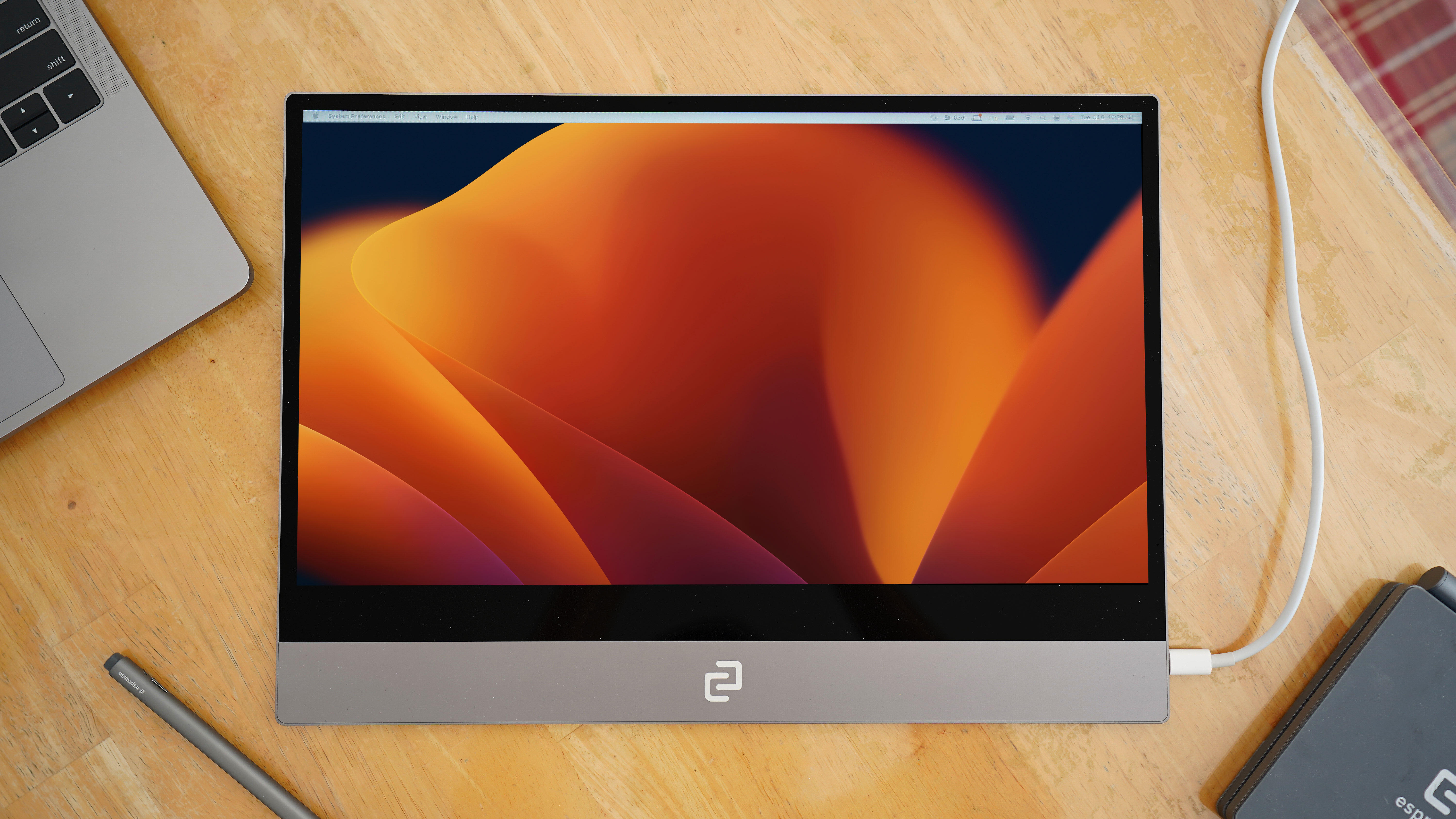
Transform Your Non-Touchscreen MacBook Into One with Detachable Screen: A Portable Monitor Review on ZDNet

Transform Your Non-Touchscreen MacBook Into One with Detachable Screen: A Portable Monitor Review on ZDNet
 Espresso Display (V2, 15-inch) 3 / 5 Good
Espresso Display (V2, 15-inch) 3 / 5 Good
pros and cons
Pros
- Sleek industrial design
- Touchscreen support for MacOS
- Plug-and-play via USB-C
- Magnetic mount is great for landscape and portrait use
Cons
- Expensive
- Monitor is wobbly
- Glossy display is not ideal
- Speakers are subpar
$499 at Amazon $499 at Espresso
more buying choices
Whether you’re working from home, the office, or a bit of both, chances are you’ve considered adding a monitor or two to your computing setup. While choosing the right monitor layout can be a pain in the rear, a portable monitor is a great starting point. They’re mobile, take up less space than traditional displays, and often come at a cheaper price.
ZDNET Recommends
That mostly holds true with the Espresso Display V2, save for the cheaper price bit. Fundamentally, the Display V2 serves as a primary or secondary screen, mirroring or extending from your desktop, laptop, or mobile device – much like every other portable monitor. Where the Display V2 differentiates itself is in design and form factor, which the company touts as the thinnest and lightest on the market.
The 15-inch touchscreen model that I’ve been testing costs $499 , which isn’t the most expensive portable monitor out there, but it’s a marginal step up from the sub-$200 offerings that you’d typically find on Amazon . Here’s my review of it.
Specifications
| Size | 359x256x5.3mm |
|---|---|
| Display | 1920x1080p at 60Hz |
| Brightness | 300 nits |
| Aspect ratio | 16:9 |
| Weight | 865g |
| Build material | Aluminum |
| Compatibility | Mac, Windows, Android, iOS, tablets |
| Price | $499 |
Designed for minimalists
The 15-inch display produces punchy and sharp-looking images. I wish it was matte instead of glossy, though.
June Wan/ZDNET
Part of the reason for Espresso’s lofty asking price is its industrial design. The Display V2’s record-setting claim is backed by 5.3mm of thickness and 620g (for the 13-inch model). The monitor is as thin as portable monitors come, which makes it excellent for slipping into a backpack, flexing around the home office, and carrying from place to place.
Equally impressive is the aeronautical-grade, aluminum unibody that gives the Display V2 its sturdy and metallic figure. Typically with cheaper monitors (often made with plastic), you’ll hear the slightest creaking when moving them around and fidgeting between orientations. That hasn’t been the case with this model, and I’ve felt comfortable enough tucking it in a bag with my laptop, books, and all.
Don’t worry, a hidden layer of cushioning separates the Display V2 from the laptop.
June Wan/ZDNET
The monitor has two USB-C ports for display connection and nothing more. Gone is the 3.5mm headphone jack that was on the V1 model, and you won’t find any HDMI or USB port on the monitor, either. This can be a dealbreaker for some, especially if you’re eyeing a portable monitor to use as a standalone device. At the same time, the minimal, one-cable-rules-all approach is what makes the Display V2 as thin as it is.
More: Best portable monitors to get work done
How it works
At this point, I should mention that the Display V2, by default, is sold as a monitor only. The magnetic stand that turns it into a mini iMac display costs extra ($69), as do all the other practical accessories that Espresso suggests you use. From my week of using the monitor, I think the magnetic stand plays too significant of a role to be sold separately. Not only does it allow you to easily rotate the Display V2 from landscape to portrait mode, but it offers two tilt points for flexible viewing. I’d happily pay for the accessory, but I wish I didn’t have to.
The optional magnetic stand is thin and can be folded down when not used.
June Wan/ZDNET
Setting up the Display V2 was as simple as connecting the monitor to my primary device via the included USB-C cable. Unfortunately, other USB-C cables would register the Display V2 as a touchpad and not a monitor, so you’ll want to keep the bundled cable safe and secure (but if you want a $499 touchpad, then that’s cool, too).
I tested the Display V2 with a MacBook Pro, Windows desktop, and Android phone, all of which successfully detected the monitor and naturally extended their content onto it soon after. With a 16:9, 60Hz, 1920 x 1080p panel, the Display V2 does an adequate job of displaying webpages, pictures, and videos. You can connect it to a Nintendo Switch as well, but don’t expect the best graphics and performance, even at $499.
To make the most out of the touchscreen, you’ll want to download Espresso Flow , a Mac- and Windows-supported software that enables multi-touch gestures and motion-based detection for when you rotate the monitor.
More: How to choose the right monitor layout for WFH
Portrait orientation is great for long-form, vertical content.
June Wan/ZDNET
There are bottom-firing speakers on the monitor, but you’re better off using the native one(s) of your connected device. It’s certainly astounding how Espresso managed to cram a functioning speaker into the chassis, but in its pursuit of slimness, the actual audio performance takes a major hit.
Finally, a touchscreen for Mac
Industrial achievements aside, the Display V2 impressed me the most by doing something that even Apple cannot: giving touchscreen support for my MacBook. As many ZDNET contributors and readers have opined , a MacBook with a touchscreen would make one of the best productivity machines even better. While the Display V2 doesn’t turn your actual MacBook display into a touchscreen, it does replicate the content, allowing you to interact with taps, presses, and swipes.
While it was fun interacting with MacOS in a different manner, the operating system was not designed for it. That means that certain elements, like the red exit button in Safari, are way too small to tap on. Expect frequent mis-presses that only Espresso’s $79 stylus can solve.
More: Dear Apple, we need a touchscreen MacBook
One cable is all that separates Apple’s reluctance and a touchscreen MacBook dream.
June Wan/ZDNET
Buy the Espresso Display V2 $683.07 at Amazon
Should you buy it?
The Espresso Display V2 is the thinnest portable monitor in the world, which means, by design, there are benefits and drawbacks. For traveling business people, hybrid workers, and digital nomads, the enhanced portability and simple set-up will be greatly appreciated. For remote and stationary workers, the ability to flex between display orientations and interact via touch comes in handy.
The things I’d watch out for are the subpar speakers, additional upcharges for accessories, and the glossy display panel, especially if you work near windows. If you can shoulder these limitations, then the Espresso Display V2 is as good as portable monitors get.
Alternatives to consider
Still on the fence? Here are some formidable alternatives to the espresso Display V2:
Lenovo ThinkVision M14t $304.92 at Amazon
The Lenovo ThinkVision M14t is another touchscreen-enabled, portable monitor that supports USB-C passthrough. While not as flexible as espresso’s monitor-stand setup, you’re still able to tilt the display up and down and station it in portrait mode. There are no built-in speakers, though.
ASUS ROG Strix 17.3’’ Gaming Monitor $449 at Amazon
If you’re eyeing a portable monitor for on-the-go gaming, then check out the ASUS ROG Strix. It has a much larger panel at 17.3 inches and refreshes at 240Hz (compared to the espresso’s 60Hz). ASUS also crammed in a built-in battery that should last up to three hours per charge.
ViewSonic 15.6’’ Touchscreen Monitor $269.99 at Amazon
For a no-frills portable monitor, we’d recommend this 15.6-inch, touchscreen offering from ViewSonic. It’s not competing with espresso to be the thinnest display out there; the thick side tray houses two USB-C ports, an HDMI port, and a 3.5mm headphone jack.
Featured reviews
Google Pixel 9 Pro XL vs. Samsung Galaxy S24 Ultra: I tested both and here are the key differences
These are the AirTags that Android users have been waiting for
This lightweight Linux distro is the best way to revive your old computer. Here’s how
The 2-in-1 laptop I recommend for the office is not a Lenovo or HP
- Google Pixel 9 Pro XL vs. Samsung Galaxy S24 Ultra: I tested both and here are the key differences
- These are the AirTags that Android users have been waiting for
- This lightweight Linux distro is the best way to revive your old computer. Here’s how
- The 2-in-1 laptop I recommend for the office is not a Lenovo or HP
Also read:
- [New] 2024 Approved Complete Drone Accessory Setlist for Expert Pilots
- [Updated] Leading iDevice Videography Tools
- 2024 Approved AV1 Essentials For the Uninitiated
- Activating Hibernation Mode on Your Windows XP System: A Comprehensive Guide
- Discover the Legitimate Best MP3 Music Downloading Sites - Ranked!
- Elevate Your Watchlist Experience with YouTube's AV1 Settings for 2024
- Free Guide: Convert Your Favorite Songs From Pandora to MP3 Format
- Immersive Gameplay Capturing with CamRecorder Pro
- Indispensable: A Comprehensive List of the Best 10 Must-Have Apps for Your Windows 10 Experience
- Master Your Desktop: Comprehensive Tutorial to Download and Install ASUS BIOS/Driver Packs
- Precision Editing for Perfect Numbers on TikTok Videos for 2024
- Quick Guide: Adding Personalized Ringtones to Your iPhone X with Ease
- Resolving Compatibility Issues for Running Windows 11 Smoothly
- Reviving Your iPhone: Tips for Starting It Up Without Functional Buttons
- Step-by-Step Instructions: How to Create a Mirrored Photo Effect on iPhone
- Ultimate Guide to Best Picture-to-Video Apps with Integrated Soundtracks
- Title: Transform Your Non-Touchscreen MacBook Into One with Detachable Screen: A Portable Monitor Review on ZDNet
- Author: Christopher
- Created at : 2024-10-05 19:52:44
- Updated at : 2024-10-11 07:34:52
- Link: https://win-guides.techidaily.com/transform-your-non-touchscreen-macbook-into-one-with-detachable-screen-a-portable-monitor-review-on-zdnet/
- License: This work is licensed under CC BY-NC-SA 4.0.